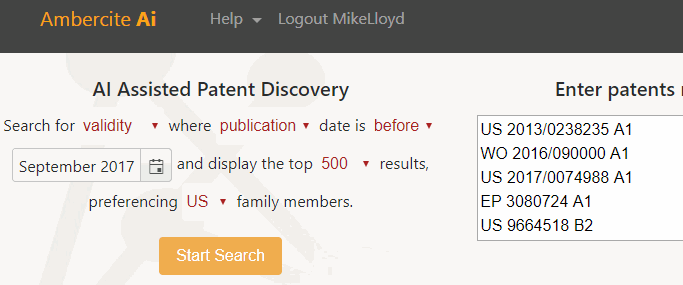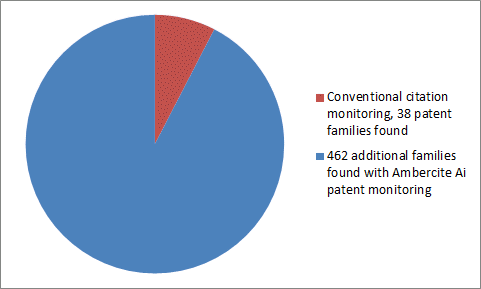Know your competitors: Case study on Strava patents
September 21 2017 Summary - Smart patent owners are long used to the concept of monitoring their competitive landscape by monitoring new patents. However existing methods could produce either too much data, or not enough. Ambercite now has the capability to provide a sophisticated and yet to use list of new and relevant patents similar to those of a portfolio, or even a single patent.
In this case study, Ambercite was used to produce a list of similar patents to the patent portfolio of Strava. No risky assumptions about keywords, patent owners or class codes were required - and this analysis returned 462 patent families - as opposed to the 38 patent families that would have been returned by conventional citation monitoring.
And if 500 similar patent families is too many, you can easily apply a date filter. For example, by applying a date filter we can see that only 7 of these families have been published in the last 6 months.
Why should patent owners monitor other patents in their areas?
Patent owners have long known that new published patent can be a valuable source of information about their known and not-yet recognised competitors:
what these competitors are developing
who could they partner with
which of these competitor's represent a legal issue and should be challenged.
Previously, patent owners could monitor new patents in their field by one or both of two methods:
By running conventional queries based on the likes of patent owner, keywords and patent codes. These can work, but equally can create a large amount of often not relevant results, thereby creating a lot of work - and sometimes this means that the technology scanning would not be done.
By looking for new forward citations from the patents in the portfolio. This can also work, but is dependent on the examiner or applicant recognising the relationship between the forward citation patent and portfolio patents. This may not happen all of the time - and hence relevant and newly filed patents can be missed.
So patents owners could end up with either too many patents to look at - or not enough (thereby key patents could be missed). Clearly, an improvement is required.
Ambercite uses and AI approach for finding similar patents to one or more patents. This makes it an excellent tool for technology monitoring, as it can monitor both known citations - and 'unknown' citations.
'Unknown' citations, in this case, are potentially relevant patents that are not yet recognised as citations - but which are found when our algorihms are applied to our network of 53 million patent families and 156 million patent citations.
And the benefit of our algorithms is that, when compared to conventional or semantic searching, the results delivered are much more precise - thereby saving your valuable time by ignoring irrelevant patents. And you can avoid the forced errors of running searches based on what could be quite risky assumptions about keywords, owners or class codes.
So how does this work in practice? The case study below might help explain this.
Case study on Strava patent portfolio
Strava is an app that can allow users to record their cycle or running trips with their smartphones, and then compare their performances with their friends and other people who use the same routes, as shown in the image below.
A search on Patentlens suggest that Stava have 53 patents to their name, falling into 9 patent families. We entered representative family members from these patent families into our patent search software Ambercite Ai, and looked for similar patents filed within the last five year, using the simple query shown below.
Note that we are running a 'validity' search, one of three options we have for patent searching. The reason why we did this is that results are listed with the earliest publication date for that family, which can help when reviewing these patents.
This produced 500 results, representing 500 patent families - the five most similar results are shown below
We can also look up the most recent published applications, as shown below. All five of these patents have some relationship to the Strava technology.
Note too that the results are all 'unknown' citations - which in fact are not citations at all, but instead similar patents which are AI algorithm suggest might be similar to the Strava patents but which have not been cited - hence they are unknown.
This distinction is important. If we look closer at the data, in fact there are only 38 known citations in this list - and 462 unknown citations. So if were to look only at known citations, a huge amount of potentially valuable data would be missed.
This now helps Strava identify some of the most similar and recent patents, whether they have been picked up as citation connections or not. But who is filing these patents? Nike, Apple and Fit bit lead this list, which is not suprising considering their interest in creating mobile devices for monitoring exercise. We produced this graph after downloading the table of results into an Excel spreadsheet.
Discussion
This simple case study show how it easy it is now is to monitor the technology landscape using Ambercite. All you need is a list of your patents - this can be the whole of your portfolio, part of your portfolio or even just one or two of your patents. The patents returned by this process can be highly relevant to your company's objectives, and be
Much more precise than conventional patent searching - saving you the time and expense of reading irrelevant patent publications
Much more data rich than conventional citation searching - if conventional citation searching had been used in this case study, it would have returned 38 similar patent families - as opposed to 462 patent families generated by Ambercite - as suggested by the image below.
Free of any errors caused by assumptions of what owners, keywords or class codes the founds patents should fall into.
Note - This blog is an updated version of a similar blog first published in May 2017. We have updated this to demonstrate some of the new features in Ambercite since May 2017..




